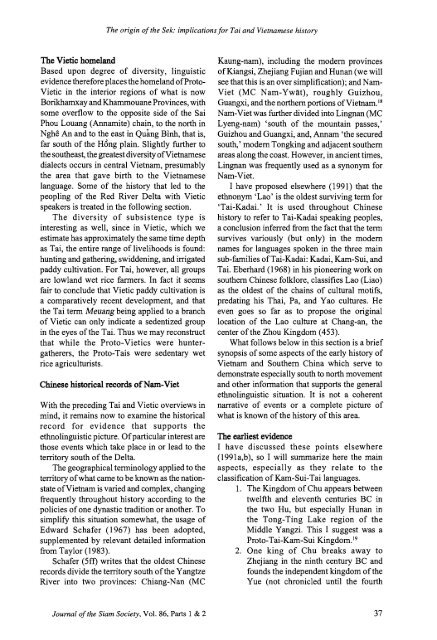The Journal of the Siam Society Vol. LXXXVI, Part 1-2 ... - Khamkoo
The Journal of the Siam Society Vol. LXXXVI, Part 1-2 ... - Khamkoo
The Journal of the Siam Society Vol. LXXXVI, Part 1-2 ... - Khamkoo
You also want an ePaper? Increase the reach of your titles
YUMPU automatically turns print PDFs into web optimized ePapers that Google loves.
<strong>The</strong> origin <strong>of</strong> <strong>the</strong> Sek: implications for Tai and Vietnamese history<br />
<strong>The</strong> Vietic homeland<br />
Based upon degree <strong>of</strong> diversity, linguistic<br />
evidence <strong>the</strong>refore places <strong>the</strong> homeland <strong>of</strong>Proto<br />
Vietic in <strong>the</strong> interior regions <strong>of</strong> what is now<br />
Borikhamxay and Khammouane Provinces, with<br />
some overflow to <strong>the</strong> opposite side <strong>of</strong> <strong>the</strong> Sai<br />
Phou Louang (Annamite) chain, to <strong>the</strong> north in<br />
Nghe An and to <strong>the</strong> east in Quang Binh, that is,<br />
far south <strong>of</strong> <strong>the</strong> H6ng plain. Slightly fur<strong>the</strong>r to<br />
<strong>the</strong> sou<strong>the</strong>ast, <strong>the</strong> greatest diversity <strong>of</strong>Vietnamese<br />
dialects occurs in central Vietnam, presumably<br />
<strong>the</strong> area that gave birth to <strong>the</strong> Vietnamese<br />
language. Some <strong>of</strong> <strong>the</strong> history that led to <strong>the</strong><br />
peopling <strong>of</strong> <strong>the</strong> Red River Delta with Vietic<br />
speakers is treated in <strong>the</strong> following section.<br />
<strong>The</strong> diversity <strong>of</strong> subsistence type is<br />
interesting as well, since in Vietic, which we<br />
estimate has approximately <strong>the</strong> same time depth<br />
as Tai, <strong>the</strong> entire range <strong>of</strong> livelihoods is found:<br />
hunting and ga<strong>the</strong>ring, swiddening, and irrigated<br />
paddy cultivation. For Tai, however, all groups<br />
are lowland wet rice farmers. In fact it seems<br />
fair to conclude that Vietic paddy cultivation is<br />
a comparatively recent development, and that<br />
<strong>the</strong> Tai term Meuang being applied to a branch<br />
<strong>of</strong> Vietic can only indicate a sedentized group<br />
in <strong>the</strong> eyes <strong>of</strong> <strong>the</strong> Tai. Thus we may reconstruct<br />
that while <strong>the</strong> Proto-Vietics were hunterga<strong>the</strong>rers,<br />
<strong>the</strong> Proto-Tais were sedentary wet<br />
rice agriculturists.<br />
Chinese historical records <strong>of</strong>Nam-Viet<br />
With <strong>the</strong> preceding Tai and Vietic overviews in<br />
mind, it remains now to examine <strong>the</strong> historical<br />
record for evidence that supports <strong>the</strong><br />
ethnolinguistic picture. Of particular interest are<br />
those events which take place in or lead to <strong>the</strong><br />
territory south <strong>of</strong> <strong>the</strong> Delta.<br />
<strong>The</strong> geographical terminology applied to <strong>the</strong><br />
territory <strong>of</strong> what came to be known as <strong>the</strong> nationstate<br />
<strong>of</strong>Vietnam is varied and complex, changing<br />
frequently throughout history according to <strong>the</strong><br />
policies <strong>of</strong> one dynastic tradition or ano<strong>the</strong>r. To<br />
simplify this situation somewhat, <strong>the</strong> usage <strong>of</strong><br />
Edward Schafer ( 1967) has been adopted,<br />
supplemented by relevant detailed information<br />
from Taylor (1983).<br />
Schafer (5ff) writes that <strong>the</strong> oldest Chinese<br />
records divide <strong>the</strong> territory south <strong>of</strong> <strong>the</strong> Yangtze<br />
River into two provinces: Chiang-Nan (MC<br />
Kaung-nam), including <strong>the</strong> modem provinces<br />
<strong>of</strong>Kiangsi, Zhejiang Fujian and Hunan (we will<br />
see that this is an over simplification); and Nam<br />
Viet (MC Nam-Ywat), roughly Guizhou,<br />
Guangxi, and <strong>the</strong> nor<strong>the</strong>rn portions <strong>of</strong>Vietnam. 18<br />
Nam-Viet was fur<strong>the</strong>r divided into Lingnan (MC<br />
Lyeng-nam) 'south <strong>of</strong> <strong>the</strong> mountain passes,'<br />
Guizhou and Guangxi, and, Annam '<strong>the</strong> secured<br />
south,' modem Tongking and adjacent sou<strong>the</strong>rn<br />
areas along <strong>the</strong> coast. However, in ancient times,<br />
Lingnan was frequently used as a synonym for<br />
Nam-Viet.<br />
I have proposed elsewhere ( 1991) that <strong>the</strong><br />
ethnonym 'Lao' is <strong>the</strong> oldest surviving term for<br />
'Tai-Kadai.' It is used throughout Chinese<br />
history to refer to Tai-Kadai speaking peoples,<br />
a conclusion inferred from <strong>the</strong> fact that <strong>the</strong> term<br />
survives variously (but only) in <strong>the</strong> modem<br />
names for languages spoken in <strong>the</strong> three main<br />
sub-families <strong>of</strong>Tai-Kadai: Kadai, Kam-Sui, and<br />
Tai. Eberhard (1968) in his pioneering work on<br />
sou<strong>the</strong>rn Chinese folklore, classifies Lao (Liao)<br />
as <strong>the</strong> oldest <strong>of</strong> <strong>the</strong> chains <strong>of</strong> cultural motifs,<br />
predating his Thai, Pa, and Y ao cultures. He<br />
even goes so far as to propose <strong>the</strong> original<br />
location <strong>of</strong> <strong>the</strong> Lao culture at Chang-an, <strong>the</strong><br />
center <strong>of</strong> <strong>the</strong> Zhou Kingdom (453).<br />
What follows below in this section is a brief<br />
synopsis <strong>of</strong> some aspects <strong>of</strong> <strong>the</strong> early history <strong>of</strong><br />
Vietnam and Sou<strong>the</strong>rn China which serve to<br />
demonstrate especially south to north movement<br />
and o<strong>the</strong>r information that supports <strong>the</strong> general<br />
ethnolinguistic situation. It is not a coherent<br />
narrative <strong>of</strong> events or a complete picture <strong>of</strong><br />
what is known <strong>of</strong> <strong>the</strong> history <strong>of</strong> this area.<br />
<strong>The</strong> earliest evidence<br />
I have discussed <strong>the</strong>se points elsewhere<br />
(1991a,b), so I will summarize here <strong>the</strong> main<br />
aspects, especially as <strong>the</strong>y relate to <strong>the</strong><br />
classification <strong>of</strong> Kam-Sui-Tai languages.<br />
1. <strong>The</strong> Kingdom <strong>of</strong> Chu appears between<br />
twelfth and eleventh centuries BC in<br />
<strong>the</strong> two Hu, but especially Hunan in<br />
<strong>the</strong> Tong-Ting Lake region <strong>of</strong> <strong>the</strong><br />
Middle Y angzi. This I suggest was a<br />
Proto-Tai-Kam-Sui Kingdom. 19<br />
2. One king <strong>of</strong> Chu breaks away to<br />
Zhejiang in <strong>the</strong> ninth century BC and<br />
founds <strong>the</strong> independent kingdom <strong>of</strong> <strong>the</strong><br />
Yue (not chronicled until <strong>the</strong> fourth<br />
<strong>Journal</strong> <strong>of</strong> <strong>the</strong> <strong>Siam</strong> <strong>Society</strong>, <strong>Vol</strong>. 86, <strong>Part</strong>s 1 & 2<br />
37

















